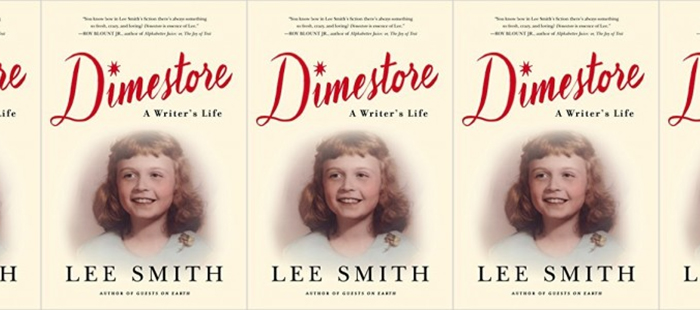Review: DIMESTORE by Lee Smith

Dimestore
Lee Smith
Algonquin, March 2016
224 pp; $24.95
Buy: hardcover | eBook
Reviewed by Amanda Forbes Silva
Confession: Until picking up a copy of Dimestore, I had never read best-selling fiction author, Lee Smith, despite her praises routinely sung by friends and colleagues.
Although I’m not proud of this disclosure, as a creative nonfiction writer, I gravitate towards nonfiction reading in an effort to hone my craft—a sort of “two birds with one stone approach,” despite my intense love of novels and fiction in general.
Recently, on a particularly dreary commute, I tuned in to NPR just in time to catch an interview dedicated to Smith’s newest title, which to my delight, is a memoir—her first, in fact. Captivated by the warmth in her voice and her candid approach to each question, I listened from start to finish, waiting in the parking lot, walking into the office late, but not in the least concerned.
On my way home that evening, I stopped to pick up a copy of Dimestore, which I already suspected was an enchanting work of nonfiction, given that it is written by a woman long celebrated for storytelling.
The verdict?
My suspicions were spot-on and resulted in my determination to read any and everything Smith has written. Hers is a voice that I will never tire of: encouraging, kind, and so forthright about the complexities inherent in life, specifically life lived as a writer, a woman, and a resident of a place that is experiencing the unpredictable transience of time, while also rooting itself in the American canon.
Smith hails from the Appalachian region, specifically, the town of Grundy, Virginia, where her father owned the one and only dime store, which has perhaps predictably been replaced by Wal-Mart. While one might assume to know Smith’s perspective on this, the brilliance of her writing is her candid acknowledgment of the complications and vagaries that characterize time, place, and people. Both a blessing and curse, the arrival of Wal-Mart signaled the end of a beloved time and place, but a new beginning, one which might have saved Grundy from permanent abandon; a “ghost town” left by industries now obsolete, economic structures suddenly unsustainable.
“Grundy may be one of the only towns in the United States that has ever actually invited Wal-Mart into its downtown area, instead of organizing against it,” Smith writes. On her 2012 visit “home,” she observed:
The sidewalks are thronged with people, all kinds of people! I don’t see one single person that I know. Finally I find a parking place in the public lot where the old stone Methodist Church once stood. I have to grin as I remember our singing ‘red and yellow, black and white, they are precious in his sight’—Grundy actually has some diversity now.
Granted, this is not all due to Wal-Mart, but also the establishment of the Appalachian School of Law and the University of Appalachia’s School of Pharmacy. The dichotomy of Smith’s observations—the gray area—and her treatment of it resonate in a universal way. Of her Wal-Mart visit and panoramic observation of “new” Grundy, she ultimately concludes: “Viewed from the top floor of Wal-Mart, the entire town looks like a toy town, like the train set Daddy always kept set up in the dimestore’s basement toy section.”
While Smith makes peace with the inevitable change that has rebirthed the Grundy of her childhood into a Grundy poised to survive – if not thrive in the future—the images she isolates in that statement reflect the pain experienced to arrive at that peace—the bitter balance of sweet nostalgia for what Smith beautifully defines as “all our little hometowns of the heart.”
Her observations on writing and how place can nurture, if not create, a writer is another compelling angle, particularly for those who question how place—or the apparent lack thereof—might influence their own work.
I immediately sympathized with one of Smith’s beloved students who bemoaned her lack of place, due to a transient childhood marked by military relocations. Not surprisingly, Smith offers comfort here by at once acknowledging this lacking sense of place or home, but refusing any power it might have to deny the development of a writer.
I told her she was lucky. But she was also right. For a writer cannot pick her material any more than she can pick her parents; her material is given to her by circumstances of her birth, by how she first hears language.
She encourages this student and all of us endeavoring to write to venture into new territory, because no matter what, “the writer puts herself in exile by the very act of writing.” Knowing that Smith is somewhere out there recasts that exile as a shared experience.
Amanda Forbes Silva received her MFA from Vermont College of Fine Arts in 2012. Her work has been published in bioStories, later anthologized in bioStories’ Mothers and Other Creatures, Empty Sink, Emrys Journal, The Riding Light Review, and Vine Leaves Literary Journal, later anthologized in The Best of Vine Leaves Literary Journal 2012.


